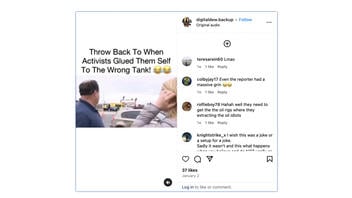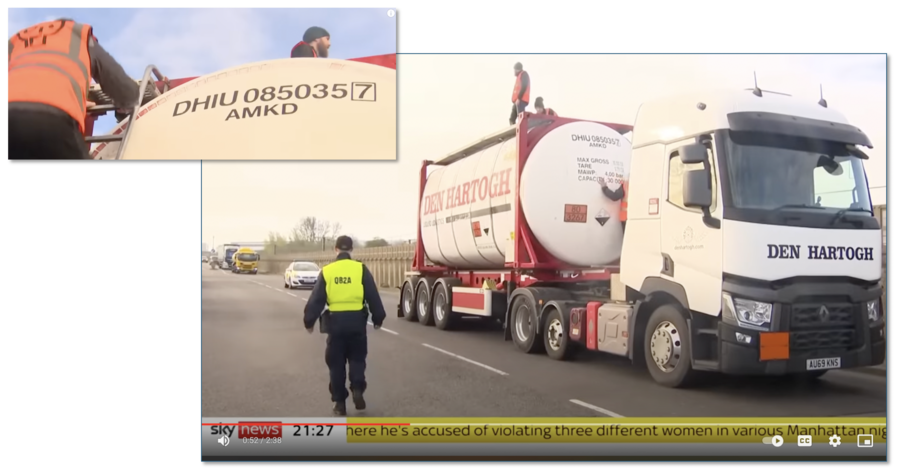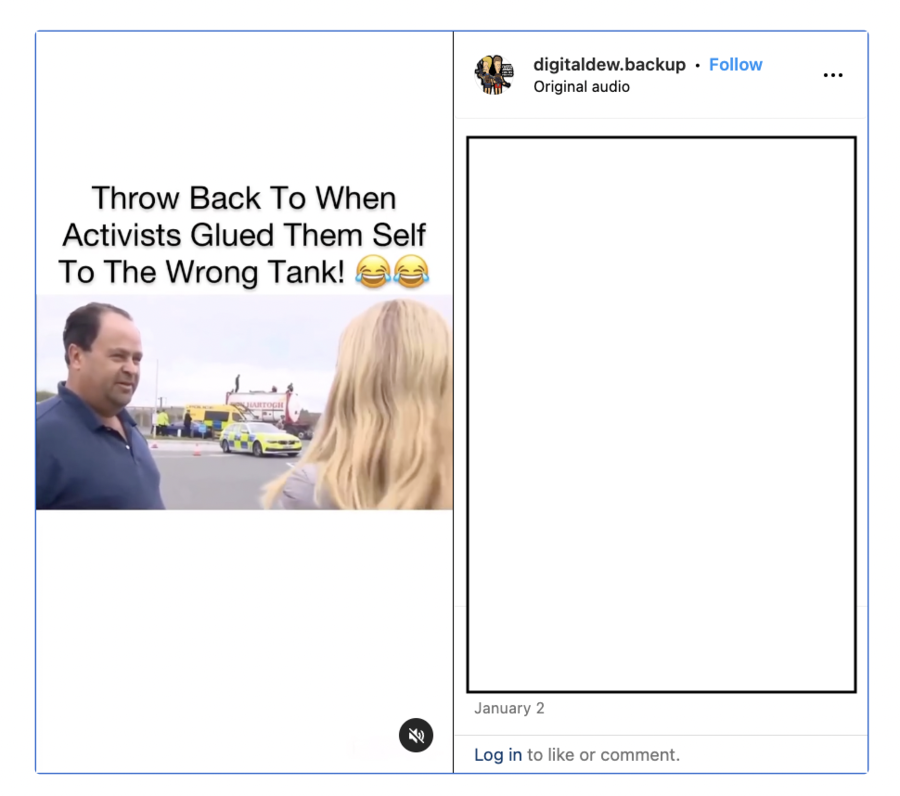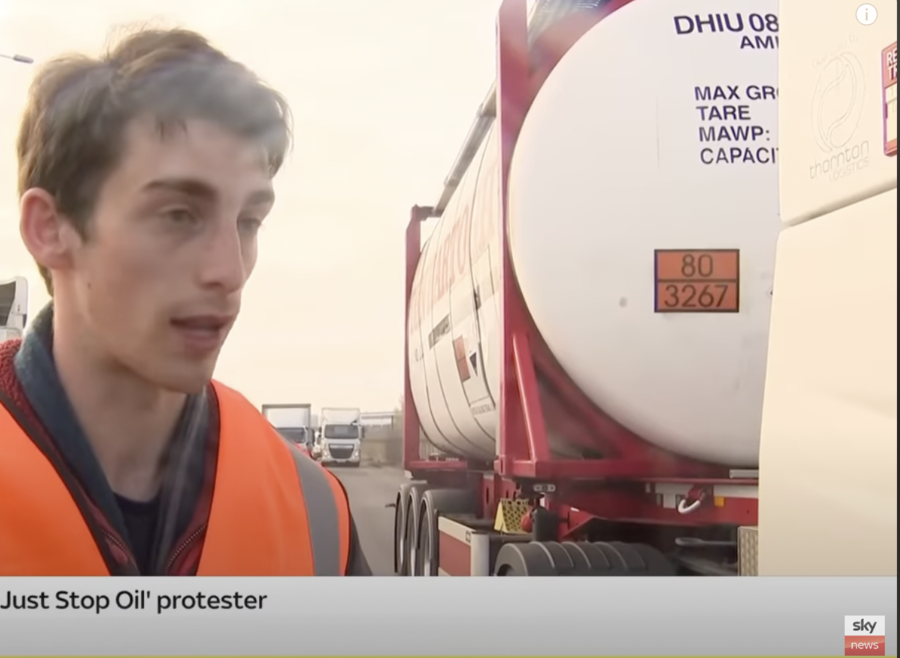
Did environmental activists protesting against the use of oil and gas in the U.K. glue themselves to a container transporting cooking oil? No, that's not true: The labels on the tank excluded the possibility that it contained vegetable oil, two independent sources confirmed to Lead Stories. That was consistent with publicly available information found on credible resources. A social media post about the activists purportedly gluing themselves to "the wrong tank" reused footage from an authentic news report. However, the person in it who brought up "cooking oil" was not an expert in the international chemical labeling system -- he was a man-on-the-street expressing his opinion about anti-oil protests through what appeared to be a joke.
The story reappeared in a video (archived here) published on Instagram on January 2, 2024, under the title:
Throw Back To When
Activists Glued Them Self
To The Wrong Tank! 😂 😂
This is what the post looked like at the time of writing:
(Source: Instagram screenshot taken on Tue Apr 9 19:30:22 2024 UTC)
The video captured the following exchange:
MAN: What, what are they achieving?
WOMAN: What they are saying is that they want maximum disruption to stop the government extracting oil and gas ...
MAN: Yeah, but that's cooking oil (laughs).
That was a fragment of a Sky News report (archived here) uploaded on YouTube on April 13, 2022. It discussed that year's environmental protests launched by the group known as Just Stop Oil. While activists did glue themselves to various immovable surfaces in some locations, the section of the report discussing cargo transportation only said that activists tried to stop those trucks.
The woman in the video was a reporter, and the man was one of the local residents she interviewed for the story. Their brief conversation took place in front of a white tanker with the logo of Royal Den Hartogh Logistics, originally a Netherlands-based company specializing in transportation "for the chemical, gas, polymer and food industry," as its website specifies (archived here).
Nothing in what the reporter said implied that the activists targeting locations associated with natural resources made a mistake, accidentally climbing on top of a container transporting cooking oil.
The Sky News footage captured a unique identifier of the tank in question: "DHIU 0850357."
 (Sources: YouTube screenshots taken on Wed Apr 10 2023 between 19:21:38 and 19:24:38 UTC; composite image by Lead Stories)
(Sources: YouTube screenshots taken on Wed Apr 10 2023 between 19:21:38 and 19:24:38 UTC; composite image by Lead Stories)
One more screenshot from the report showed a specific numeric code in the orange box:
(Source: YouTube screenshot taken on Wed Apr 10 19:26:09 2024 UTC)
Coverage by other media outlets, including the Standard (archived here) and the Independent (archived here), captured the same white container with the same markings "DHIU 0850357" and "3267."
One of those still images showed the third readable label -- in the shape of a rhombus:
(Source: Independent screenshot taken on Tue April 9 20:32:50 2024 UTC)
The black-and-white rhombus (archived here) from the image above is used to label class 8 corrosive substances.
As defined (archived here) by the United Nations Economic Commission for Europe, such items chemically "attack epithelial tissue - of skin or mucous membranes - with which they are in contact, or which in the event of leakage are capable of damaging or destroying other goods, or means of transport."
None of them are meant to be eaten, unlike cooking oil.
While the events filmed in the Sky News report took place in the U.K., many countries around the globe, including both the U.K. and the U.S. (archived here), use the same Globally Harmonized System of Classification and Labelling of Chemicals (archived here).
A spokesperson for the Pipeline and Hazardous Materials Safety Administration (archived here), which is an agency under the U.S. Department of Transportation, told Lead Stories via email on April 10, 2024:
Cooking oil in its typical form is not regulated as a hazardous material and the markings in the pictures provided do not indicate that cooking oil is being transported ... The only hazard class that could be remotely applicable to cooking oil would be Class 3 Flammable Liquids which would be identified with a different placard.
Paul Frail, a chemist with a Ph.D. in inorganic chemistry and a background in developing industrial water treatment related to corrosion, confirmed to Lead Stories via email on April 10, 2024, that transported cooking oil would have different labels:
One issue, cooking oil is considered a GRAS (Generally Recognized As Safe) chemical that is approved by various government agencies for food consumption and would not have a HCS [hazardous chemical standard] pictogram for corrosion with a class 8 rating.
He continued:
The labeling and pictogram on the truck would indicate the substance it is carrying is a corrosive liquid that can cause skin corrosion or burns, eye damage, or potentially corrosive to certain metals and alloys. The numerical code further classifies this as a basic (alkaline) liquid that is organic and has a pH greater than 12.5. One would need a copy of the SDS to know what is in the bulk container but these types of liquids can range from sodium hydroxide, cleaners, and chemical treatments used for industrial water treatment, etc.
"SDS" stands for a "safety data sheet."
Lead Stories reached out to the logistics company whose name was seen on the container in question. If we receive a response, this story will be updated as appropriate.
Publicly available examples of safety data sheets for vegetable oils (for example, here and here) further confirm that those products' labeling is different from what was seen on the surface of the Den Hartogh tank.
One example of a product listed under the UN 3267 code like the contents in the container from the video found by Lead Stories was a mold remover (archived here) sold in the Netherlands:
(Source: Trekpleister screenshot taken on Wed Apr 10 20:37:43 2024 UTC; the page was automatically translated to English by Chrome)
Other Lead Stories fact checks about international stories can be found here.



















